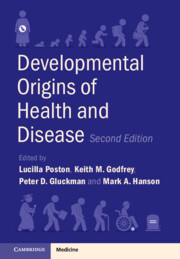Book contents
- Developmental Origins of Health and Disease
- Developmental Origins of Health and Disease
- Copyright page
- Contents
- Contributors
- Preface
- Section I Overview
- Section II Exposures Driving Long-Term DOHaD Effects
- Chapter 2 The Evolutionary Basis of DOHaD
- Chapter 3 Timing
- Chapter 4 Long-Term Effects of Food Insecurity and Undernutrition in Early Life
- Chapter 5 Short- and Long-Term Effects of Maternal Obesity and Dysglycaemia for Women and Their Children
- Chapter 6 Long-Term Effects of Prenatal Maternal Stress and Mental Health
- Chapter 7 Environmental Exposures in Early Life
- Chapter 8 Developmental Programming and the Microbiome
- Chapter 9 Exposures Driving Long-Term DOHaD Effects
- Section III Outcomes
- Section IV Mechanisms
- Section V Interventions
- Section VI Public Health and Policy Implications of Interventions
- Index
- References
Chapter 9 - Exposures Driving Long-Term DOHaD Effects
Influence of Assisted Reproductive Technologies
from Section II - Exposures Driving Long-Term DOHaD Effects
Published online by Cambridge University Press: 01 December 2022
- Developmental Origins of Health and Disease
- Developmental Origins of Health and Disease
- Copyright page
- Contents
- Contributors
- Preface
- Section I Overview
- Section II Exposures Driving Long-Term DOHaD Effects
- Chapter 2 The Evolutionary Basis of DOHaD
- Chapter 3 Timing
- Chapter 4 Long-Term Effects of Food Insecurity and Undernutrition in Early Life
- Chapter 5 Short- and Long-Term Effects of Maternal Obesity and Dysglycaemia for Women and Their Children
- Chapter 6 Long-Term Effects of Prenatal Maternal Stress and Mental Health
- Chapter 7 Environmental Exposures in Early Life
- Chapter 8 Developmental Programming and the Microbiome
- Chapter 9 Exposures Driving Long-Term DOHaD Effects
- Section III Outcomes
- Section IV Mechanisms
- Section V Interventions
- Section VI Public Health and Policy Implications of Interventions
- Index
- References
Summary
Almost 40 years ago David Barker made his observation that poor in utero growth increased cardiovascular disease risk in the offspring. A few years prior to this, the first baby to be conceived through IVF was born. Since then, an estimated 8 million babies worldwide have been born via one form or another of Assisted Reproductive Technology (ART). However, data from experimental animal and human clinical studies have highlighted the period around conception as being particularly sensitive to sub-optimal environmental conditions. Furthermore, there is growing concern that aspects of the ART procedures themselves may alter fetal and neonatal growth and increase the incidence of cardiovascular and metabolic diseases, cancer, asthma and neurodevelopmental issues in the children. However, a large degree of confounding factors including parental infertility, disparity in ART culture media and methods, and even the design of the follow-up studies, mean that further investigations are required in the definition of causal relationships between ART and child health.
- Type
- Chapter
- Information
- Developmental Origins of Health and Disease , pp. 75 - 84Publisher: Cambridge University PressPrint publication year: 2022

